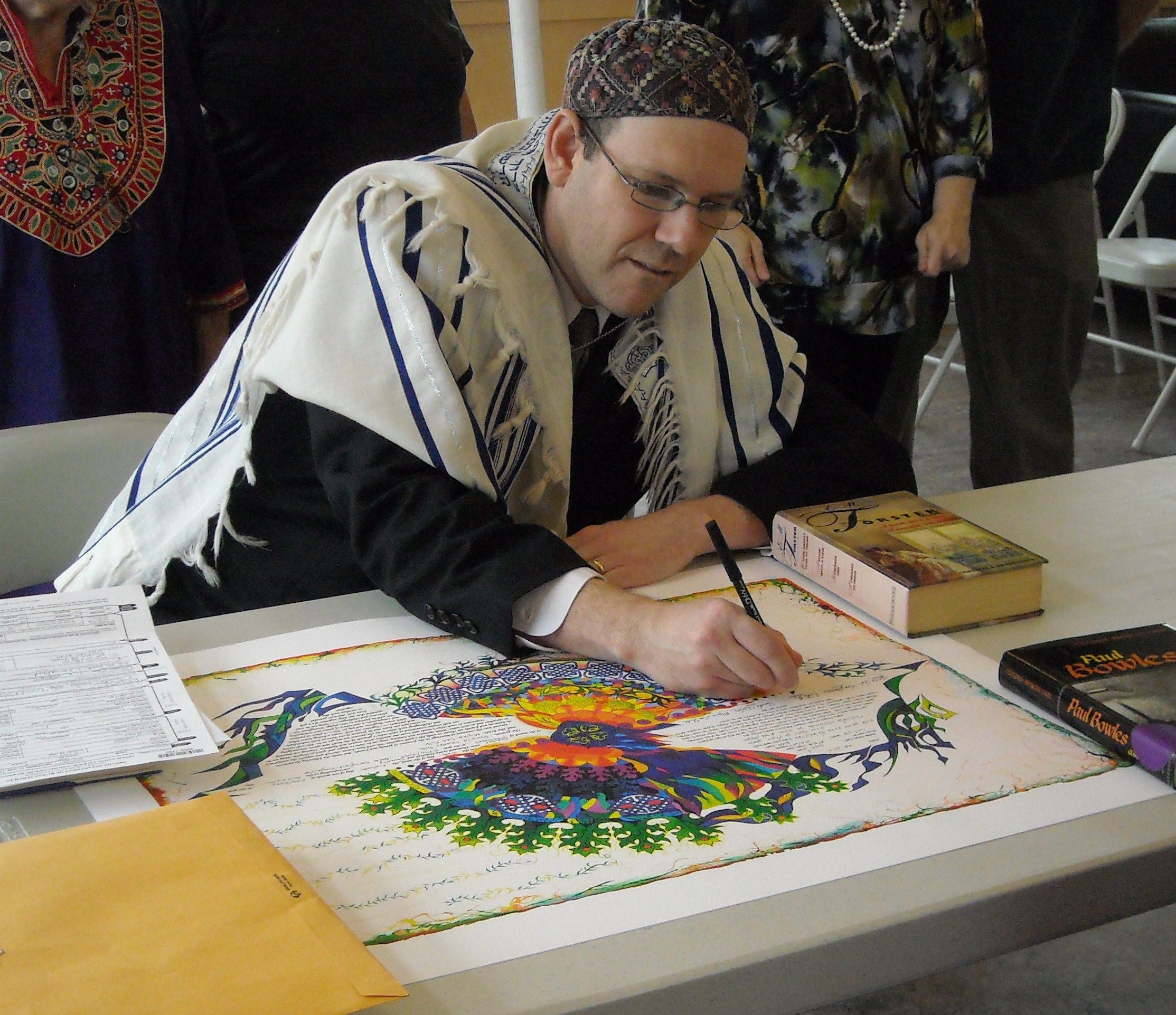ב___ בשבת ב__________ יום לחדש ______ שנת חמשת אלפים ושבע מאות ו____________ לבריאת העולם למנין שאנו מונים כאן ב_________________ במדינת ארצות הברית באמריקה. אנו עדים איך החתן _________________ למשפחת ____________ אמר לכלה _________________________ למשפחת _________ הרי את מקודשת לי בטבעת זו כדת משה וישראל. ואיך הכלה __________________ אמרה לחתן ____________________ הרי אתה מקודש לי בטבעת זו כדת משה וישראל. החתן _____ והכלה _____ קבלו על עצמם כל תנאי קידושין ונישואין המוטלים עליהם מן התורה ומכח בתי דין של חכמינו זכרונם לברכה. ועוד הסכימו החתן ____ והכלה ____ מרצונם לעבוד אחד עבור השני ולכבד ולפרנס ולזון זה את זו וזו את זה ולחיות חיי משפחה ולבנות יחד בית נאמן כמקובל לבני ולבנות ישראל. הכלה _____ קבלה טבעת מבחיר לבה והחתן ____ קבל טבעת מבחירת לבו לשם קידושין ולסמל אהבתם. החתן ____ והכלה ____ גם קבלו על עצמם אחריות לתנאי כתובה זו ולכסף ולכלי הבית הבאים עמם מבתיהם ומבתי משפחותיהם. והסכימו שתגבה כתובה זו אפילו מנכסים שאין להם אחריות. וקבלנו קנין מהחתן ________________ למשפחת _______ לטובת הכלה_________________________ למשפחת __________ ומהכלה ______________________ לטובת החתן
_____________________________ בכלי הכשר לקנין והכל שריר וקים
נאום ______________________________
נאום ______________________________
Transliteration:
B_____ ba’shabbat b________ yom l’khodesh ______ sh’nat hameshet, alpaim u’shva meot v_____ l’vriat haolam l’minyan sheanu monim kan b________ bimdinat aratzot habrit ba’America. Anu eydim eikh heykhatan _____ l’mishpakhat _______ amar la’kallah _______ l’mishpakhat _______ harey at m’kudeshet li batabat zo k’dat Moshe v’yisrael. V’eikh hakallah _____ amrah la’khatan _______ harey atah m’kudash li batabat zo k’dat Moshe v’yisrael. Heykhatan _____ v’hakallah _____ kiblu al atzmam kol t’nai kidushin v’nisuin hamutalim aleyhem min haTorah u’mikoakh batey din shel khakhameynu zikhronam livrakha v’od haskimu heykhatan ______ v’hakallah _____ meyrtzonam la’avod ekhad avor hasheyni u’lkhabed u’lfarnes l’hazin zeh et zo v’zo et zeh v’lkhiot khayey mishpakha v’livnot yakha beyt ne’eman kimkubal livney v’livnot Yisrael. Hakallah ______ kiblah taba’at mibkhir libah v’heykhatan kibel taba’at mibkhirat libo l’sham kidushin u’lsemel ahavatam. Heykhatan v’hakallah gam kablu al atzmam hakhrayut lat’nai k’tubah zo v’lakesef u’lkheyley habayit habaim imam mibateyhem u’mibmey mishpkhoteyhem v’haskimu shetigbey k’tubah zo afilu minkhasim she’ayn lahem akharayut v’kiblanu kinyan meykeykhatan _______ l’mishpakhat _____ l’tovat hakallah _____ l’mishpakhat ____ u’meyhakhalah ____ l’tovat heykhatan. B’khaley hakasher lakinyan v’hakol sharir v’kayem.
English:
On the _________ day of the week, the ______ day of the month ________, in the year 57__, as we are accustomed to reckon it here, in _____________ in the United States of America, we hereby testify that the groom _________ of the family ________ said to the bride _________ of family ________, “You are consecrated to me as my wife, with this ring, according to the laws of Moses and Israel,” and that the bride __________ said to the groom _________, “You are consecrated to me as my husband with this ring, according to the laws of Moses and Israel.” The groom ___________ and the bride ___________ accepted all the conditions of betrothal and marriage as set forth by biblical law and by the rulings of the Sages of blessed memory. The groom and bride further agreed willingly to work for one another, to honor, support and nurture one another, to live with one another, and to build together a household of integrity as befits members of the Jewish people. The bride accepted a ring from the groom, and the groom accepted a ring from the bride, for the purposes of creating this marriage and to symbolize their love. The groom and bride also accepted full legal responsibility for the obligations herein taken on, as well as for the various property entering the marriage from their respective homes and families, and agreed that the obligations in this Ketubah may be satisfied even from movable property. We have had both the groom and the bride formally acquire these obligations to the other, with an instrument fit for such purposes. Thus all is in order and in force.
Signed: _________________ (witness)
Signed: _________________ (witness)
A Brief Commentary to the above Ketubah
With respect to the omission of the explicit monetary provisions, and sufficing with a reference to the obligations that obtain, one should note that the only elements of the ketubah which are obligatory are the mohar and the lien which it engenders. The lien (achrayot) is explicitly stated in this text, and the mohar is referenced. Even Haezer 69:1–2, 6, makes it clear that the obligation is independent of the exact wording of the ketubah, and since this does nothing to contradict that, there can be no objection on this front.
As for the mutuality of the obligations (I’m not now speaking of the kiddushin formula itself), it is worth looking at Ze’ev Falk’s short note in the Journal of Jewish Studies 1957, pp. 215ff, and Mordecai Friedman’s dissertation on the Palestinian Ketubot, pp. 67 and 74. Such mutual wording is not unprecedented, though the existence of some precedent along these lines is not by itself sufficient to compel the adoption of mutual wording today. Contemporary understandings and practices of marriage are far more important in this respect.
Now, the stickiest issue is the kiddushin formula, though it is not, strictly speaking, a potential problem with the ketubah. For one thing, this ketubah could perfectly well be modified so as to eliminate the bride’s declaration to the groom, if the couple chooses not to have symmetrical declarations. Moreover, the ketubah is independent of kiddushin, and in it the witnesses are merely testifying as to what they heard. But what about the validity of the kiddushin act itself, under the huppah, when the bride says harey atah m’kudesh li (behold, you are betrothed to me)? Here, I would call attention to Even Haezer 27. Paragraph 1, for example, makes it clear that one of the important determinants about what counts as a valid kiddushin formula is what the parties understand by the language used, and what the local usage is. Moreover, paragraphs 6–7 make it further clear that a critical issue is whether the language is active or passive. Active is normative. Passive is invalid. Indeed, the baraita in Kiddushin 5b does not mention the language harey atah m’kudesh li but rather discusses the case where the woman says hareni m’kudeshet lecha. The problem with that is not necessarily that the woman is saying it, but rather that the language is passive. The Rambam says as much (in Hilchot Ishut 3:1–2), where he notes that the problem is that it is lashon hakna’a, i.e., passive language. In that entire chapter, the Rambam never considers the possibility of the woman saying harey atah m’kudesh li. Undoubtedly, it wasn’t an issue for the Rambam, or for the baraita, because that simply wasn’t what anyone understood by marriage. This is further underscored by the Tosafot in Kiddushin 4b. There the Tosafot express some consternation that Rashi (in a formulation that differs from our own text of Rashi) would have interpreted the Gemara’s disqualification of kiddushin declared by the woman to mean the hypothetical case of a woman saying harey atah m’kudesh li. According to the Tosafot, that’s an impossible understanding of the Gemara because it’s absurd. It simply doesn’t apply to marriage as they knew it. The Tosafot make the point that the Gemara must have been disqualifying the passive language of harey ani m’kdushet lecha, and then when it is meant as a replacement for the usual declaration of the male. (A further interesting point is that the compilers of the Piskei Tosfot did not list this dismissal of harey atah m’kudesh li as a ruling of law, for it was no such thing. It was merely a critique of Rashi’s understanding of the text based on the patent meaninglessness [in the time of the Gemara] of the phrase). Now our understanding of marriage, a millennium after Rabbenu Gershom, and given the pervasive mutuality in our culture concerning marriage, is such that active language on the part of the woman is anything but absurd, and thus can be part of a marriage formula in which the groom’s parallel (and traditional) declaration is not displaced. Given all of this, and the fact that there is no doubt (given that the caterer has been paid, etc.) what everyone is up to (that is, the condition of “speaking with her about matters of kiddushin” is more than met) one can only conclude that this additional active declaration cannot invalidate the marriage. Anyone who feels otherwise should have the burden of proof.
Finally, one might note Even Haezer 27:8 in the Biur Hagra where he quotes the Rosh in order to make an even stronger point about a woman’s declaration even in the absence of a man’s declaration (which is not what is advocated by this ketubah). According to the Rosh, a woman making the declaration (here it clearly means the passive one) after the man gives the ring, in the midst of “the act of kiddushin,” is a valid marriage because (27:1) he could give the ring and say absolutely nothing in such a circumstance and it would be a valid marriage. Thus, her saying anything at all can’t make that worse than saying nothing!
A final note: all of the above is formulated for the benefit of the positivist or one who wishes to satisfy that point of view. Needless to say, given a different jurisprudential perspective, other powerful reasons could be given to support the mutuality of declaration.
This ketubah may certainly be used, but it should not be published or otherwise distributed without the author’s permission. Please also note that it currently has no official status.













